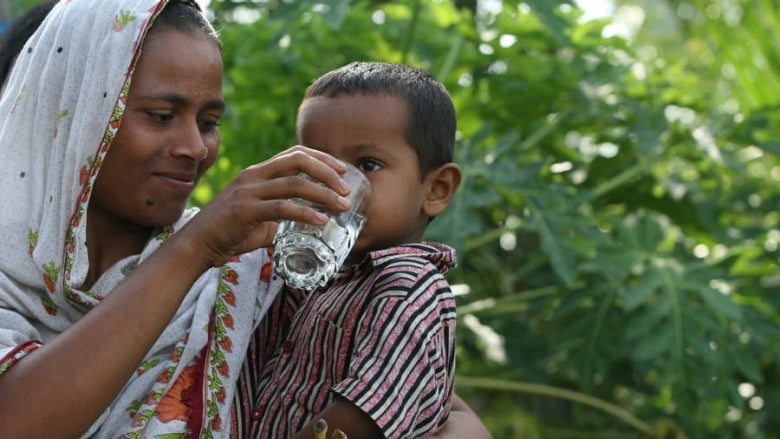 Photo Credit: World Bank
Photo Credit: World Bank
Clean, safe water is never taken for granted in rural Bangladesh, which is home to 75 percent of the country’s population, or 109.3 million people. E. coli bacteria, dangerously high arsenic levels, excessive salt, iron, and other pathogens are among the contaminants commonly found in rural water sources.
Fortunately, the International Development Association (IDA) stands ready to support the most vulnerable developing countries and to make key investments to grow and transform their economies and improve the lives of their citizens.
The IDA-funded Bangladesh Rural Water Supply and Sanitation Project has improved the water supply for almost 1.5 million people and delivered hygienic latrines for 247,500 people . It is among 48 projects currently supported by IDA in Bangladesh, totaling $12.6 billion. Bangladesh is one of the largest recipients of IDA’s low-interest credits, grants, and knowledge.
IDA is contributing to remarkable achievements across South Asia.
In IDA’s current three-year funding cycle that ends in 2020, the program will provide almost 75 million people with improved health and nutrition services, support 9.9 million people through social safety nets, install 500 MW of renewable energy capacity, and provide job and training opportunities to 450,000 people.
These are transformative changes in a region that boasts the highest economic growth rates in the world but is still home to one-third of the world’s poor.
Poverty has steadily declined and basic health and education indicators have improved. But human capital deficits are large and multi-dimensional poverty, which measures household and individual deprivations in health, education, and standard of living is estimated at 26.6 percent, far above the global average of 18.3 percent.
The region is exposed to climate change impacts and frequent natural disasters. Droughts, floods, and cyclones destroy homes and crops and disrupt livelihoods.
Fragility and conflict bring destruction and death, driving migration and imposing disproportionate social, economic, and security burdens on host communities, infrastructure, and services.
And growing global financial and trade uncertainties may further undermine growth and development.
To address these vulnerabilities, we are working with development partners and stakeholders to effectively use core IDA resources and special funding windows.
The IDA story in the region is the story of results at scale.
Since the early 1960s, India has advanced from a primarily agrarian economy with deeply entrenched poverty, food shortages, poor health indicators, and low levels of literacy, to one which is now a global player with one of the world’s fastest-growing economies.
Another recent IDA graduate in South Asia is Sri Lanka, which is transitioning from a predominantly rural-based economy to a more urbanized economy oriented around manufacturing and services.
Sri Lanka has made significant progress in its socio-economic and human development indicators. Today, its social indicators rank among the highest in South Asia and compare favorably with those in middle-income countries.
South Asia countries that remain IDA recipients continue to demonstrate strong achievements. Here are a few country-specific examples of results from IDA-funded projects.
In Afghanistan, 350,000 rural poor women have increased their incomes and 8,150 Community Development Councils are helping to improve service delivery in rural areas of the country.
In Bangladesh, 260,000 Rohingya women received gender-sensitive counseling on reproductive health.
In Nepal, 650,000 residents received climate-resilient housing and 500 small- and medium-sized agribusinesses benefitted from value chain support.
In Pakistan, 200,000 displaced households in the Federally Administered Tribal Areas (FATA) received grants for child health check-ups and services.
But for millions of people in South Asia, daily life is still harder than it should be, and we know that IDA-funded programs will continue to be important for these people. Going forward, we will continue responding to countries’ needs and supporting their development priorities.
IDA’s global focus on achieving progress in the areas such as gender, fragility and conflict, climate change, governance, and jobs and economic transformation aligns well with our strategic priorities in South Asia.
Thanks to its unique blend of financial resources and knowledge, we are confident that IDA will continue to lift people out of poverty and improve their living standards.






Join the Conversation